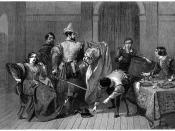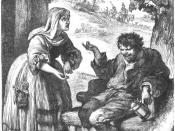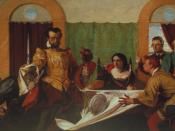" Sir Assurance, Let's each one send unto his wife And he whose wife is most obedient to come at first when he doth send for her shall win the wager which we will propose." (The Taming Of The Shrew p107).
This stood out to me as an excellent representation of the plays meaning, and of the views that people had towards women in the 16th and 17th centuries. William Shakespeare's play "The Taming Of The Shrew" is a story about a wealthy Count (Pertruchio), who comes to the country of Padua to find himself a wealthy woman for a bride. He finds his bride in the form of Katherina, a beautiful yet shrewish young Woman. The rest of the play is concentrated mainly on Pertrucio, and his amusingly comical mission to tame Katherina of her stubborn, and argumentative ways. Many other humorous sub plots also accompany this main theme.
After reading and studying "The Taming Of The Shrew" in detail, I am going to answer this essay question, Does " The Taming Of The Shrew" provide the audience with a fair representation of the treatment of, and views towards, women in the 16th and 17th centuries?
To produce an intelligent piece of work, I have researched the lives of women in the 16th and 17th centuries. I have also researched sources the Shakespeare himself used to write the play.
In my essay, I am going discuss the lives of women in the 16th and 17th centuries, and how Shakespeare represented this in "The Taming Of The Shrew". I am also going to discuss how the two main female characters (Bianca and Katherina) were made to appear in the play, and how the other characters treated them.
Shakespeare was born in 1564,


